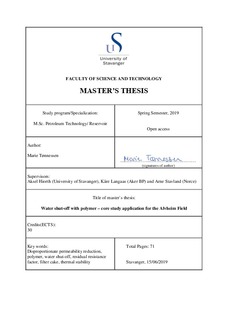| dc.description.abstract | This thesis is an experimental study where different polymers have been evaluated for disproportionate permeability reduction (DPR) effects. The laboratory work was performed at Norce, for Aker BP, as a part of the Master’s degree program in Petroleum Technology at the University of Stavanger (UiS).
The main goal was to give additional support to an earlier experimental research initiated by Aker BP. In 2014 during a well intervention, Flowzan was injected into a Kneler well on the Alvheim field. Normally starch-based polymer was used for this type of well intervention, but this time, Flowzan was injected by a mistake. Results from this operation showed reduced productivity of the well and a reduced fraction of water. These results triggered a more in-depth study to investigate if Flowzan could be used as a method for water shut-off. Since Aker BP is planning a new pilot to inject polymer on the Alvheim field, the experimental work in this thesis was to test different polymers for DPR effects.
The laboratory work included viscosity measurements, filtration tests and core flood experiments. The experiments were performed on four polymers; three different versions of Xanthan (Flowzan, Barazan and FDP-S1235-16) and one type Scleroglucan (CS6). The polymers were diluted in Alvheim Formation Water (AFW). Simple filtration tests were performed for each polymer at three different pressures (10, 20 and 50 bar) with respectively three different filter sizes (41, 20, 8 µm), at 20 ◦C. The same filtration test with 50 bar and filter size 8 µm, was performed at 70 ◦C with Flowzan and CS6. Core flood experiments with Flowzan, Barazan and CS6, were the last part of the laboratory work. Polymer injection, and backflooding with AFW and Isopar, were performed at Alvheim reservoir temperature, 70 ◦C. Two core flood experiments were completed for Flowzan injection, one experiment for Barazan injection, and one experiment for CS6 injection. After polymer injection and backfloooding with both AFW and oil, the cores were divided in four segments, and each part were separately backflooded with AFW.
Viscosity measurements showed that the viscosity for all Xanthan polymers were the same, while Scleroglucan had a lower viscosity. From the filtration tests at 20 ◦C, Flowzan and Barazan indicated some plugging of the filter while CS6 showed total plugging. Filtration tests (with 50 bar and filter size 8 µm) at 70 ◦C showed that Flowzan still plugged in the filter while CS6 had excellent filtration. Results from core flooding experiments showed that Flowzan and CS6 plugged into the core, but positive DPR effect (RRFo RRFw. Visual inspections of the treated cores with Flowzan and Barazan revealed filter-cake formation at the core inlet. From the four segments, it was observed that the water permeability increased with the distance moving from the inlet, i.e. the permeability reduction depends on invasion depth.
Since all Xanthan polymers had the same molecular weight but different plugging properties, plugging can be explained by impurities/debris attached to the polymer. These impurities depends on the treatment processes of the polymer product and may vary from different vendors. Since poor filtration was caused by impurities, it is very important to perform a filtration test before a polymer product is selected for a DPR treatment.
The life-time of Xanthan and Scleroglucan was also of interest. An estimation of the lifetime assumed that long-term thermal stability tests could be matched with an exponential decay. From this decay it was observed that even though Scleroglucan have been reported a higher thermal stability, Xhantan at 70 ◦C should last for several years.
Thus, from this laboratory work, Flowzan was recommended as the best candidate for disproportionate permeability reduction treatment at the Alvheim Field (at 70◦C). Zones and baffles in the Alvheim reservoir makes it possible to reduce the fraction of water and can contribute to increased oil reserves where zones with remaining oil and low pressure support can be produced more efficient. | nb_NO |

